
Burnet County is a county located on the Edwards Plateau in the U.S. state of Texas. As of the 2020 census, its population was 49,130. Its county seat is Burnet. The county was founded in 1852 and later organized in 1854. It is named for David Gouverneur Burnet, the first (provisional) president of the Republic of Texas. The name of the county is pronounced with the emphasis or accent on the first syllable, just as is the case with its namesake.

Burnet is a city in and the county seat of Burnet County, Texas, United States. Its population was 6,436 at the 2020 census.

The Goliad massacre was an event of the Texas Revolution that occurred on March 27, 1836, following the Battle of Refugio and the Battle of Coleto; 425–445 prisoners of war from the Texian Army of the Republic of Texas were executed by the Mexican Army in the town of Goliad, Texas. The men surrendered under the belief they would be set free within a few weeks; however, this was not to be. Despite appeals for clemency by General José de Urrea, the massacre was carried out by Lt. Colonel José Nicolás de la Portilla, under orders from General and President of Mexico, Antonio Lopez de Santa Anna.
Henry Percy Brewster was a lawyer, statesman, and soldier from Texas. He fought in the Texas Revolution, and as a colonel in the Confederate Army during the Civil War.

Erastus "Deaf" Smith, who earned his nickname due to hearing loss in childhood, was an American frontiersman noted for his part in the Texas Revolution and the Army of the Republic of Texas. He fought in the Grass Fight and the Battle of San Jacinto. After the war, Deaf Smith led a company of Texas Rangers.
Felix Huston (1800–1857) was a lawyer, soldier, military opportunist and the first commanding general of the Army of the Republic of Texas under the Constitution of 1836.

The "Old Three Hundred" were 297 grantees who purchased 307 parcels of land from Stephen Fuller Austin in Mexican Texas. Each grantee was head of a household, or, in some cases, a partnership of unmarried men. Austin was an American approved in 1822 by Mexico as an empresario for this effort, after the nation had gained independence from Spain. By 1825 the colony had a population of 1,790, including 443 enslaved African Americans. Because the Americans believed they needed enslaved workers, Austin negotiated with the Mexican government to gain approval, as the new nation was opposed to slavery. Mexico abolished it in 1837.
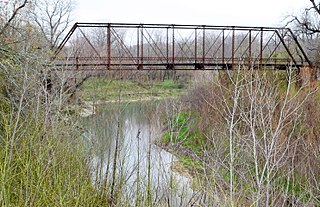
The Little River is a river in Central Texas in the Brazos River watershed. It is formed by the confluence of the Leon River and the Lampasas River near Little River, Texas in Bell County. It flows generally southeast for 75 miles (121 km) until it empties into the Brazos River about 5 miles (8.0 km) southwest of Hearne, at a site called Port Sullivan in Milam County. The Little River has a third tributary, the San Gabriel River, which joins the Little about 8 miles (13 km) north of Rockdale and five miles southwest of Cameron. Cameron, the county seat of Milam County and the only city of any significant size on the Little River, was established in 1846.

The Austin–Round Rock–San Marcos metropolitan statistical area, or Greater Austin, is a five-county metropolitan area in the U.S. state of Texas, as defined by the Office of Management and Budget. The metropolitan area is situated in Central Texas on the western edge of the American South and on the eastern edge of the American Southwest, and borders Greater San Antonio to the south.
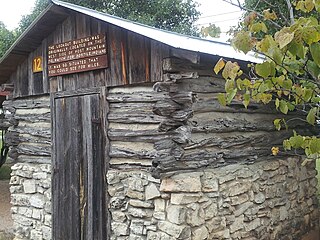
Fort Croghan was the third of the first four forts established by the United States government to protect settlers from hostile Indians along the Texas frontier. From its establishment on March 18, 1849, by Lt. C.H. Taylor until it was abandoned in 1855, Fort Croghan was home to Company C, 8th Infantry, U.S.A. (mounted), and eventually became the headquarters of the Second Dragoon Regiment.
Peter Kerr, also known as Peter Carr, was one of the founders of Burnet, Texas, and a member of the Old Three Hundred, the original settlers in Stephen F. Austin's colony.
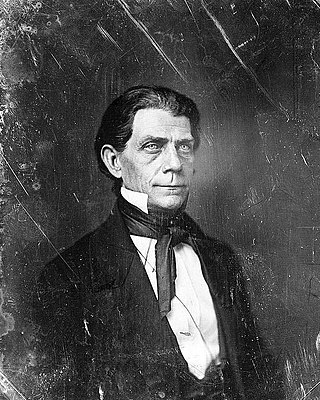
Memucan Hunt was the first Minister of Texas to the United States, Secretary of the Texas Navy, and an unsuccessful candidate for Vice-President of the Republic of Texas.
The Battle of the Brazos River was an engagement fought in the Brazos River on April 17, 1837, between the Mexican Navy and the Texian Navy.

Central Texas is a region in the U.S. state of Texas roughly bordered on the West by San Saba to the Southeast by Bryan and the South by San Marcos to the North by Hillsboro. Central Texas overlaps with and includes part of the Texas Hill Country and corresponds to a physiographic section designation within the Edwards Plateau, in a geographic context.
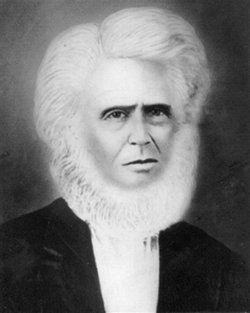
Greenleaf Fisk (1807–1888) was a pioneer, known as "the Father of Brownwood, Texas". When a land and water dispute necessitated a new site for Brown County's seat of Brownwood, Fisk donated the land for the new location. He was a military veteran of the Texas Revolution and was a member of the Republic of Texas House of Representatives. Fisk was a Chief Justice when he lived in Bastrop, Texas. When he relocated his family to Brown County, he became a substantial land owner and served the people in several positions of local government. In 1968, the home of Greenleaf Fisk was designated a Recorded Texas Historic Landmark. February 25, 2004, the home was put on the National Register of Historic Places.
Andrew Jackson Sowell was a lifelong soldier and farmer in the 19th century. He was a participant in the Texas Revolution and a survivor of the siege of the Alamo. He continued his service during the years of the Republic of Texas, in the Mexican–American War, and the Civil War. He was a frontier defender, early Texas Ranger, and a friend and scout with Kit Carson.
Julien Sidney Devereux (1805-1856) was an American planter and politician from Texas.
Robert M. Coleman was a Texan and later American politician, soldier, and aide-de-camp to Sam Houston. Coleman was a signer of the Texas Declaration of Independence, a Colonel, and a transitional founder of the Republic of Texas into the United States as a constituent state. His opposition to the strategies of Sam Houston regarding defense of the Alamo and troop placements on up through the Battle of San Jacinto caused a rift with Houston and a posturing treatise. This lent suspicion to Coleman's death by drowning.

Noah Smithwick was a colonist who lived in Texas from 1827 and until the Civil War began. A gunsmith and blacksmith, he fought in the Texas Revolution and served as a Texas Ranger. Late in life he dictated his recollections of this early Texas period to his daughter, relaying colorful and humorous accounts, which included legendary Texans Stephen F. Austin, James Bowie, William B. Travis, Thomas Jefferson Rusk, and Sam Houston, who he knew personally.
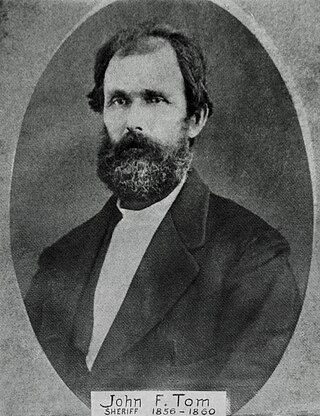
John Files Tom, a descendant of Irish immigrants moved as a boy with his family from Tennessee to Texas to impact Texas history with his involvement in many key roles that shaped Texas including but not limited to: Texas Revolutionary War Veteran, Sheriff of Guadalupe County, Texas, Texas Ranger Captain during the Civil War and a Representative in the 13th Texas State Legislature, was born on April 22, 1818, in Cathey's Creek in Maury County, Tennessee to William Tom and Mary Susan Files Tom.
3. Vandeveer Papers: Vertical Files Herman Brown Free Library of Burnet County
















